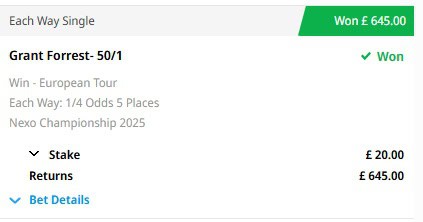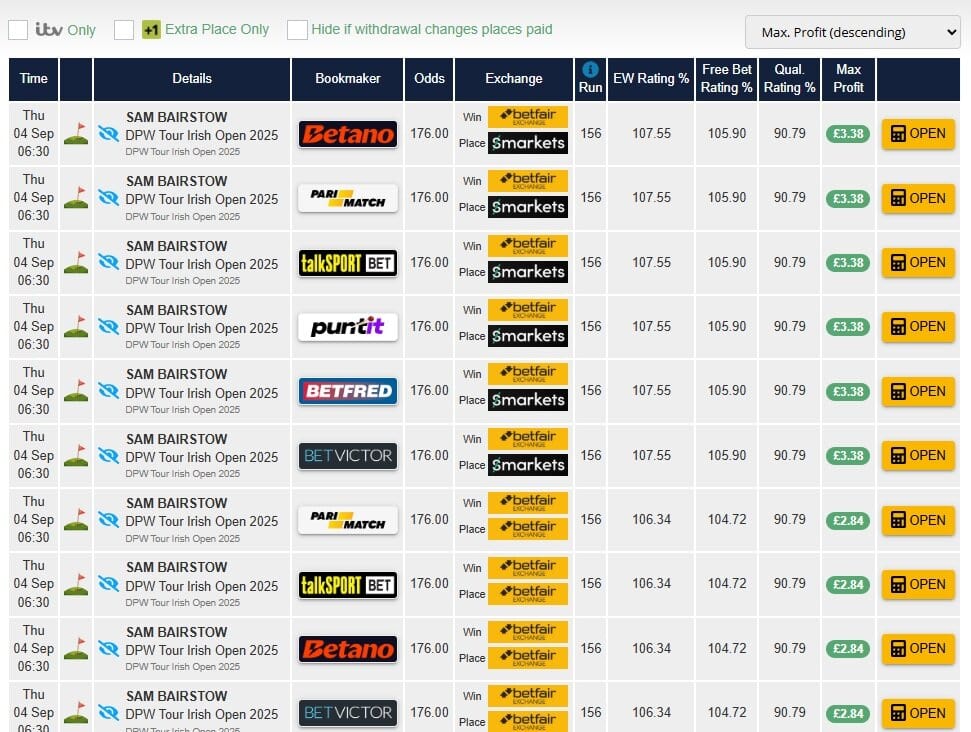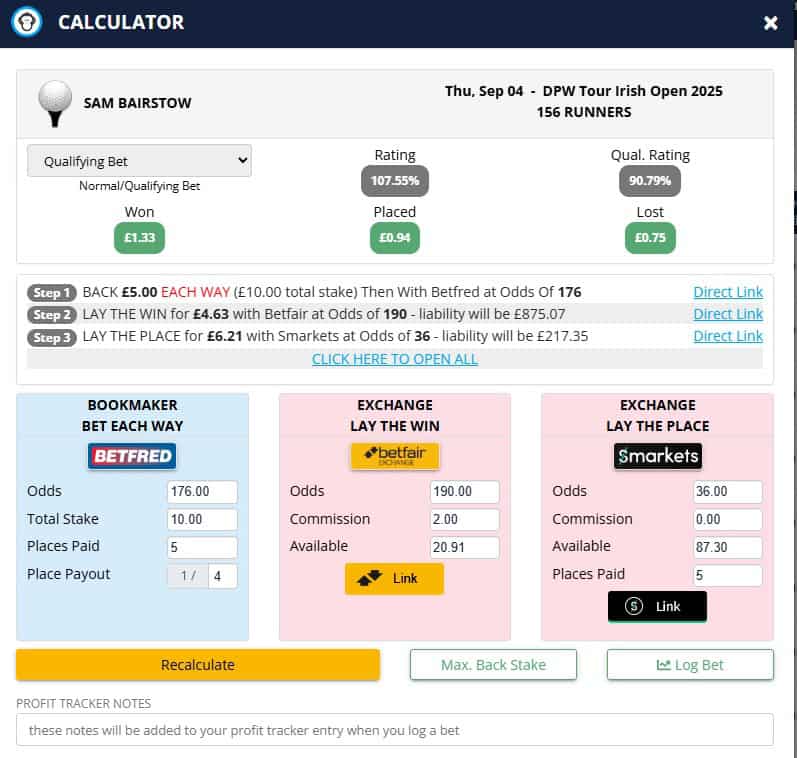Golf betting presents a unique opportunity in the sports wagering landscape. Unlike team sports where you’re choosing between two outcomes, golf offers a field of 150+ players, creating value opportunities that sharp bettors can exploit. In this guide I’ll show you a systematic approach that consistently identifies profitable betting situations.
The key to successful golf betting isn’t just picking winners it’s understanding how to extract value from a market that most recreational bettors approach without correct research.

Understanding Golf Betting Markets
Golf offers several distinct betting markets, each requiring a different strategic approach. The most common markets include:
Tournament Winner (Outright)
This is where most beginners start, but it’s also where they lose money fastest. With 150+ players and only one winner, you need odds of at least 150/1 to break even long-term if you’re picking randomly. The real opportunity lies in identifying undervalued players based on current form and course fit.
Top 5/Top 10/Top 20 Finishes
These markets offer better odds of success while still providing decent returns. A player finishing in the top 10 might offer 4/1 odds compared to 40/1 for an outright win, but your hit rate increases dramatically.
Each Way Markets
An each way market operates like two separate bets. One bet is placed on the winner market and a second bet equal to the same stake is placed on the top 5 unless a bookmaker is offering extra places with happen frequently.
Head-to-Head Matchups
This is where experienced bettors often find the most consistent value. You’re betting on which of two players will finish higher, typically offered at close to even odds. Success here depends on thorough player analysis rather than luck.
Live Betting
Golf’s four-day format creates numerous in-play opportunities. Weather changes, early round struggles, or momentum shifts can create significant value swings throughout the tournament.
Simple Strategy To Profit From Golf
Now that you understand the various markets available for golf betting, let’s explore the simplest strategy for making consistent profits. This is the very approach I’ve successfully used to generate returns in the golf betting markets.
Exploiting Each Way Terms and Extra Places
One of the easiest ways to profit from golf betting is by leveraging the each-way terms and extra places offered by bookmakers. While this isn’t the only profitable strategy, it’s certainly the most straightforward. The value in golf betting often lies in these each-way bets and extra places, primarily due to the differences in how bookmakers and betting exchanges operate. Betting exchanges, driven by sharp money and market efficiency, often provide the best indication of whether a bet offers value. By comparing bookmaker odds with exchange odds, you can uncover opportunities to exploit these discrepancies.
Example: Sam Bairstow as a Value Selection

For instance, this week, Sam Bairstow has been flagged as a value selection by specialized software I use to identify profitable golf betting opportunities. The value in this case comes from the each-way portion of the bet.
Here’s how it works:
- Bairstow’s odds to win are 176.00 to back and 190.00 to lay on the exchange.
- However, his place odds are 44.00, which is significantly higher than the 36.00 available on the exchange.
This creates an arbitrage opportunity, allowing you to lock in a small profit regardless of the outcome.
Breaking Down the Bet

Here’s a breakdown of how the bet works:
1.Each-Way Back Bet (Bookmaker):
- £5 is placed at odds of 176.00 (win market).
- £5 is placed at odds of 44.00 (place market).
2.Lay Bet on the Exchange:
- £4.63 is laid at odds of 190.00 (win market).
- £6.21 is laid at odds of 44.00 (place market).
By structuring the bet this way, you secure a profit regardless of whether Bairstow wins, places, or misses the cut.
The best approach that I have found is to bet these selections as straight value bets and profit will be made in the long term. Whilst you may not profit on every bet over the long term if you consistently take value bets such like these profit will be made.
Long-Term Profitability
While arbitrage opportunities like this can yield small, guaranteed profits, the best approach I’ve found is to treat these selections as straight value bets. Over the long term, consistently betting on value selections will lead to profits, even if individual bets don’t always win.
Golf Betting Software
To consistently identify value bets, I rely on two key pieces of golf betting software:
1.OddsMonkey’s Each-Way Pro Software: This tool, part of OddsMonkey’s broader matched betting and value betting package, is designed to uncover value in each-way bets across various sports. In the example above, it highlighted Bairstow as a value selection.
2. 20-Minute Betting System: This software uses a proprietary algorithm to scan betting markets and identify value in each-way golf bets. For example, in the image above, Coral is offering 8 places instead of the standard 5 places, creating additional value. The software flagged several golfers as profitable selections due to these extra places.

Click Here To Learn more about the 20 minute golf system.
Analyzing Player Performance
Effective golf betting starts with comprehensive player analysis. Raw world rankings tell only part of the story—you need to dig deeper into the data that actually predicts performance.
Recent Form Analysis
Look beyond just wins and losses. A player missing cuts might still be striking the ball well but struggling with putting, or vice versa. I track strokes gained statistics across different categories:
- Strokes gained off the tee
- Strokes gained approach
- Strokes gained around the green
- Strokes gained putting
A player showing improvement in multiple categories, even without wins, often presents betting value before the market catches up.
Course History Matters
Some players consistently perform well at specific venues regardless of current form. Track not just past finishes, but scoring averages and strokes gained data at each course. A player who’s finished top 20 in three consecutive years at a venue deserves serious consideration, even if their recent form appears mediocre.
Playing Style vs Course Setup
Match player strengths to course demands. Long hitters have advantages on courses favoring distance, while precise iron players excel on target golf courses. Weather conditions amplify these advantages—windy conditions favor experienced links players, while calm conditions level the playing field.
Physical and Mental State
Monitor player interviews, social media, and recent life events. Players dealing with equipment changes, swing modifications, or personal issues often struggle initially before potentially breaking through. Conversely, players in good mental spaces often outperform their recent statistics.
Course Conditions and Environmental Factors
Weather and course conditions dramatically impact tournament outcomes, creating opportunities for bettors who properly assess these variables.
Wind Impact
Wind affects different players dramatically. Check historical data for how players perform in windy conditions. Links-style courses in wind favor players comfortable with low, controlled ball flights over those who rely on high, soft approaches.
Firm vs Soft Conditions
Firm conditions favor accuracy over distance, as balls run out and miss rough penalties become severe. Soft conditions allow more aggressive play and favor powerful players who can attack pins. Monitor weather forecasts and adjust player selections accordingly.
Pin Positions and Setup
Tournament organizers announce daily pin positions and rough heights. Difficult setups favor experienced players and course veterans who understand how to navigate challenging conditions. Easy setups often produce more bunched leaderboards where putting performance becomes crucial.
Altitude and Temperature
High altitude courses play significantly longer, favoring distance players. Hot conditions affect ball flight and player endurance differently. These factors often get overlooked by casual bettors but significantly impact outcomes.

Bankroll Management for Golf Betting
Golf betting’s high variance demands disciplined bankroll management. Even the best strategies experience cold streaks, and proper bankroll management ensures you survive these inevitable downturns.
Unit Sizing Strategy
Never risk more than 2-3% of your total bankroll on any single bet, regardless of confidence level. Golf’s unpredictable nature means even “sure things” fail regularly. I typically structure my bets as:
- Standard plays: 1 unit
- Strong conviction plays: 2 units
- Maximum plays: 3 units (rare)
Diversification Approach
Spread risk across multiple bet types rather than putting everything on outright winners. A typical tournament might include:
- 2-3 outright selections at different price points
- 3-4 top 10 positions
- 2-3 head-to-head matchups
This approach provides multiple ways to profit from your research while reducing overall risk.
Tournament Selection
Not every tournament offers good betting opportunities. Focus on events where you have strong conviction about specific players or course setups. Forcing bets on every tournament dilutes your edge and increases variance.
Record Keeping and Analysis
Track every bet with detailed reasoning. This creates accountability and helps identify successful patterns in your approach. Record not just wins and losses, but near-misses and the reasoning behind each selection.
Key Takeaways
Successful golf betting requires a systematic approach combining thorough player analysis, course condition assessment, and disciplined bankroll management. The most profitable opportunities often come from identifying undervalued players who fit specific course profiles rather than simply backing favorites or hot players.
Focus on building an edge through detailed research rather than hoping to get lucky with longshot winners. Take advantage of the lucrative extra place offers that bookmakers offer and use software to help highlight the best opportunities. Remember that golf betting is a marathon, not a sprint. Even the best strategies experience losing streaks, but consistent application of sound principles leads to long-term profitability.